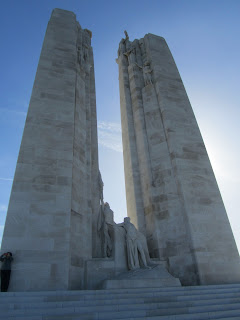 |
| The wall of the Norman fort in Caen |
We continued our adventures with my parents, heading out of Paris on a Sunday morning.
Juno beach was peaceful when we made our pilgrimage on a late May afternoon. We'd stayed in Caen the night before and made the short drive to the coast. The sand was bright and inviting, shifting gently in the Atlantic breezes.
Although the image of absolute chaos, of bodies strewn over the beach while bullets and shells flew overhead is difficult to place in this now quiet and pretty stretch of beach, the reminders are everywhere. The sand is slowly covering the big, squat German bunkers that line the whole coast, but these imposing structures are easy to find and explore. Tanks and big guns now form memorials to the soldiers who struggled up the beach to liberate Normandy.
 |
| Sunken bunker near Juno Beach |
We went down the coast and found the remains of the Mulligan harbour, which my Dad swam out to touch in the eighties, and wandered around a coastal battery. We found the small town where the 1st Hussars, his regiment since the 70s, was decimated a week after the landings in the push towards Caen, and we finished the day at a Canadian war cemetary - incredibly well kept and beautiful.
And that was the easy day, history-wise.
We had an easy night - kebab for dinner, my Mom's new favourite food, and after a game of euchre (so nice to play something other than rummy!) we went to bed early.
The next morning we took off north from Caen for a veritable scavenger hunt of war sites. First to Dieppe, just up the coast, to stand in the wind under the huge, steep cliffs, and to see the slippery stone beach where so many Canadian soldiers died in a botched raid in 1942.
Tired, but determined we drove south from Dunkirk to Vimy. As you approach the town, the Canadian war monument is visible on the ridge for kilometres, its freshly restored white marble easy to pick out among the forests surrounding it.
 We barely made the last tour of the site, led again by a Canadian student. I'm glad we did - its the only way down into the tunnels. We toured through a tunnel (one of a massive complex) and saw a few rooms, and returned to the surface through the exit used on the day the battle began, where the soldiers stood nervous and primed for combat.
We barely made the last tour of the site, led again by a Canadian student. I'm glad we did - its the only way down into the tunnels. We toured through a tunnel (one of a massive complex) and saw a few rooms, and returned to the surface through the exit used on the day the battle began, where the soldiers stood nervous and primed for combat. We wandered the reconstructed trenches until the site closed, and then spent some time at the monument, enjoying the fact that we were on Canadian soil, for Dan and I the first time in two months.
We drove from Vimy across the northern border and through the flat Belgian countryside right to Brussels - by the time we found the hotel and parked the car, it had been 14 hours since we'd left Caen.
 |
| The Butte de Lion: the only hill in Belgium, as far as I could tell. It's man-made. |
We spent the next day at the battlefield in Waterloo, climbed the Butte de Lion and visited the former headquarters of both Wellington and Napoleon, then had the best burgers I've had in months at a little restaurant in Waterloo. My parents left the next morning to return to Paris to end their trip.
So for those of you who know my Dad, I think it was pretty much a dream vacation for him. He was a reservist in the 1st Hussars for much of his life, and a peace keeper with the UN force in the Golan Heights. He is a military history re-enactor and a police officer. He is, at heart, very much a soldier, and so to visit these places is to pay homage to his brothers in arms.
For me, these sights would have been interesting in their own right. But with my Dad at the wheel as tour guide and interpreter, offering explanations and insights and taking us to these incredibly moving sites that we'd have otherwise missed - for me, this made the experience so much richer.
S.
 |
| Reconstructed trench at Vimy Ridge |

No comments:
Post a Comment